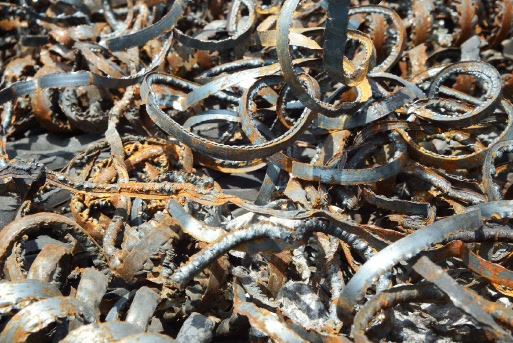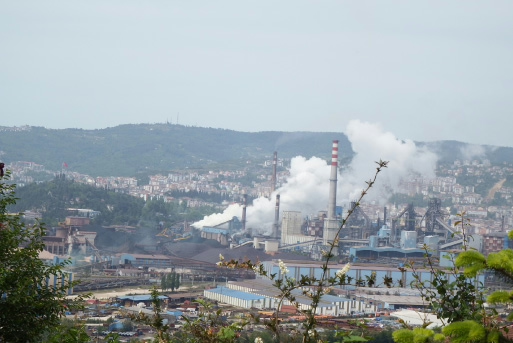
Worldwide, coal is primarily burned in power stations to produce electricity. The UK stopped burning coal to produce electricity in October 2024, and in November 2024 announced its commitment to rule out any new coal mining projects. Yet the UK continues to use coal in various industries - consuming 1.46 million tonnes of coal in 2024.
The use of coal contributes to these industries' carbon footprint, both in the mining and burning of coal. This undermines the UK's emission reduction targets and risks perpetrating neo-colonial patterns of off-shoring polluting industry. It's vital that these industries are both encouraged and supported to switch to using proven coal alternatives in their industrial processes.
 WORLDWIDE
WORLDWIDE
The direct use of coal as a feedstock (not just energy) is particularly significant in China, where coal is used extensively in coal to gasification plants to produce chemicals such as methanol, ammonia, and polyvinyl chloride (PVC). In 2017, China's chemical industry alone used about 180 million tonnes of coal as feedstock, which constituted about 5% of China’s total coal use that year.
China is unique in its heavy reliance on coal for chemical manufacturing, accounting for a large share of global coal-to-chemicals production. For example, 89% of methanol and 76% of ammonia production in China is coal-based, and producing 1 tonne of methanol from coal requires about 2.7–3 tonnes of coal.
India is also expanding its coal gasification capacity, with government plans to gasify 100 million tonnes (MT) of coal annually by 2030
In contrast, other major chemical-producing regions (Europe, North America, Middle East) primarily use natural gas or crude oil as feedstocks rather than coal.
UK
There is negligible or close to zero coal gasification industry in the UK as of 2025: over the past 20 years, gasification projects have focused on waste or biomass, rather than coal.
![]()
WORLDWIDE
Global brick production was estimated at 2.18 billion tonnes in 2020, resulting in approximately 500 million tonnes of CO2e (1% of current global GHG emissions). Brick production could rise to 3.35 billion tonnes by 2050. Approximately 375 million tonnes of coal are used globally per year in brick production, mostly as fuel to heat kilns. Research indicates that coal is added to clay bricks at rates of 1–15% by weight of the clay mixture.
Switching from coal to alternative fuels, together with more efficient kilns, will lead to reduced CO2 emissions.
UK
Heating brick-firing ovens in the UK uses a mix of natural gas, electricity, coal and coke, diesel and LPG fuels. The primarily for use of coal in bricks, though is as an additive to colour it. According to coal mining company, Energybuild Ltd, UK brickworks consume approximately 70,000 tonnes per year of additives, which includes coal.
Annual tonnage of anthracite coal used by the UK brickmaking industry is not made public but the proportion used within the UK generally falls within the range of 1–5% of the brick mix by weight, depending on the desired product characteristics. This contributes to the high emissions released from the raw brick materials upon firing.
![]() WORLDWIDE
WORLDWIDE
Activated carbon is typically made from charcoal (wood) and is a common filtration medium in water treatment systems. It can be manufactured from other sources, with anthracite coal being a common source. Alternatives include nutshells. These sources are first processed into activated carbon through high-temperature treatment to create a porous structure suitable for adsorption
The global market for coal-based activated carbon was valued at approximately USD 4.44 billion in 2024, with demand driven by applications in air purification and water treatment.
Alternatives to the traditional sand/activated carbon dual medium to filter water include glass, garnet, magnetite, and other materials.
UK
The exact annual tonnage of anthracite coal used by the UK water filtration industry is not made public but it does use both domestically mined and imported coal.
 WORLDWIDE
WORLDWIDE
The cement industry consumes around 4% of global coal production, which amounts to approximately 330 million tonnes per year. Most of this coal is combusted to generate the heat required to fire the kilns to about 1450c to create the chemical reaction that produces cement. Roughly 0.5 tonnes of coal are needed to produce 1 tonne of cement.
Coal in cement production is primarily used as a fuel to heat kilns, and the burnt coal ash can also serve as a minor feedstock into the clinker. Fly ash and blast furnace slag (both waste coal products) are used as a substitute for clinker in cement production, and can increase the concrete durability. By using substitutes for kiln-based ‘clinker’ in cement production, the cement industry can significantly reduce its carbon footprint. Post-consumer waste can also be used as an alternative fuel to reduce the coal used to heat the kilns, helping to decouple coal from the cement industry.
UK
Of the cement sold in the UK in 2024, 33% was imported. UK cement manufacture has begun switching from traditional fossil fuels such as coal and pet-coke to the use of waste, waste biomass and waste part- biomass fuels. These alternative fuels now account for 43 per cent of the fuel used (2020), replacing the equivalent of half a million tonnes of coal every year. This means 1.16 million tonnes of coal would be used if it weren’t for replacement fuels, and 660 thousand tonnes of coal is still used in UK cement manufacture.
UK carbon dioxide emissions from concrete and cement were 7.3 million tonnes in 2018; around 4.4 million tonnes of this was ‘process emissions’ from clinker production, 2.2 million tonnes from fuel combustion, and the remainder from electricity use and transport. Owing to decline in cement production and increases in efficiency, the sector's direct and indirect emissions are 53% lower than 1990. UK concrete and cement accounted for around 1.5% of UK carbon dioxide emissions in 2018. UK Government research and commercial examples from around the world indicates that the elimination of fossil fuels is possible with no negative impact on clinker quality, kiln stability or build-up issues.
![]() WORLDWIDE
WORLDWIDE
The steel industry produces 9-11% of the annual CO2 emitted globally, contributing significantly to climate change. This is largely due to the reliance on coking coal in primary steel production. 4 of the 5 biggest global steel producers aim to reach carbon neutral steel production by 2050, using green hydrogen instead of coal.
UK
Scunthorpe Steelworks still relies on coal-based steel production, and is the second biggest single site emitter of CO2 in the UK. Port Talbot steelworks recently closed to convert to using electricity to recycle scrap steel, decoupling it from coal inputs. The other two large steel producers – Liberty Steel and Celsa also recycle scrap steel in ‘electric arc furnaces’.
To keep up with global decarbonisation trends, Scunthorpe steelworks needs to decarbonise as well. If not, customers aiming to reach their own climate goals will likely choose to import lower carbon steel from other European countries like Sweden and Spain who are pursuing low-emissions steelmaking projects.
Read more about coal in steel in our 2021 report.
![]() Graphite is a naturally occuring substance used in everything from pencils to batteries. Anthracite is one of several suitable carbon-heavy materials that can be used to make artificial graphite. If anthracite is used to make artificial graphite, it must be heated to extreme temperatures of 1,000c for ‘baking’ and up to 4,000c for ‘calcination’ to remove impurities making up 8% of the anthracite. This stabilises the artificial graphite end product. The heating would release greenhouse gasses in a similar way to if it were burned for household heating.
Graphite is a naturally occuring substance used in everything from pencils to batteries. Anthracite is one of several suitable carbon-heavy materials that can be used to make artificial graphite. If anthracite is used to make artificial graphite, it must be heated to extreme temperatures of 1,000c for ‘baking’ and up to 4,000c for ‘calcination’ to remove impurities making up 8% of the anthracite. This stabilises the artificial graphite end product. The heating would release greenhouse gasses in a similar way to if it were burned for household heating.
This process can be avoided by using natural graphite and scrap graphite. The UK doesn’t manufacture any artificial graphite and UK demand is also relatively low: “UK is a small net importer of natural and synthetic graphite”.

The UK steel and cement sectors (and to a lesser extent, bricks) are the largest users of coal following the closing down of the UK’s last coal-fired power station in September 2024. Check out our coal dashboard for our most recent coal stats including an industry break-down. We support the UK Government’s commitment to ban…

The steel industry produces 9-11% of the annual CO2 emitted globally, contributing significantly to climate change. In 2024, on average, every tonne of steel produced led to the emission of 2.2 tonnes of CO2e (scope 1, 2, and 3). Globally in 2024, 1,886 million tonnes (Mt) of steel were produced, emitting…

Successful, at-scale, examples already exist of cement works burning 100% fuel alternatives to traditional fossil fuels, including pilot projects using combinations of hydrogen and biomass (UK) and hydrogen and electricity (Sweden). Yet, innovations such as use of hydrogen and kiln electrification are…

The direct use of coal as a feedstock (not just energy) is particularly significant in China, where coal is used extensively in coal to gasification plants to produce chemicals such as methanol, ammonia, and…

(Türkçe olarak mevcuttur) Coal Action Network investigated the Turkish coal industry in 2024. This article looks at our findings and the links between Turkish coal, air pollution, Russia’s war and decarbonisation.

In Spring 2024, Coal Action Network investigators visited Turkey to see first-hand the impacts that imported coal was having on communities living near steelworks and power stations using coal. At that time, planning permission was in place for West Cumbria Mining Ltd to extract 2.78 million tonnes of coal a year, until 2049, from a coal mine under the sea near Whitehaven, Cumbria, UK.

Former steelworker, Pat Carr, spoke to Anne Harris from Coal Action Network about the financial support offered to workers when the Consett steelworks closed in 1980, and they discussed what can be done better, in workplaces like Scunthorpe steelworks. (Article published in Canary magazine)

Former steelworker, Pat Carr, speaks to Anne Harris from Coal Action Network about the financial support offered to workers when the Consett steelworks closed in 1980.

Port Talbot Steelworks in South Wales is the largest producer of virgin steel in the UK. Along with British Steel steelworks in Scunthorpe, Port Talbot steelworks is expected to shut down its blast furnaces in 2024 and build a 3 million tonne (MT) electric arc furnace (EAF) to recycle scrap steel. This is a measure to reduce the steelworks CO2 footprint by cutting out coal used in traditional blast furnaces in virgin steelmaking.

People hailing from Cumbria to London, and everywhere in between, descended on the Mines and Money Conference in London across two days (28th-29th Nov 2023). We demanded that investors stop pouring cash into the mining sector, and instead invest in our collective future. Together with Fossil Free London and other groups, we greeted investors with…